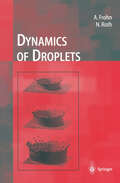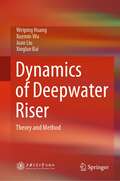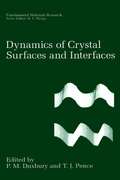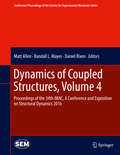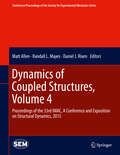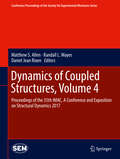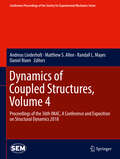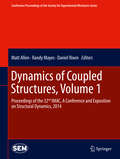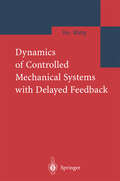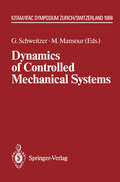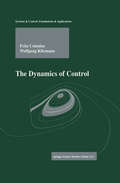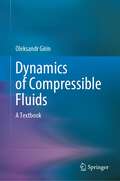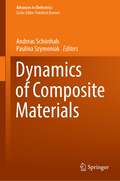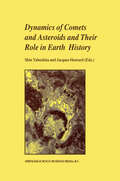- Table View
- List View
Dynamics of Droplets (Experimental Fluid Mechanics)
by Arnold Frohn Norbert RothThe book deals with the dynamical behaviour of single droplets and regular droplet systems. It has been written mainly for experimental researchers. After a short description of the theoretical background, the different experimental facilities and methods necessary for the investigation of single droplets are described in detail. A summary of important applications is included.
Dynamics of Disaster: Lessons on Risk, Response and Recovery (The Earthscan Science in Society Series)
by Barbara Allen Rachel A. Dowty BeechDisasters are the result of complex interactions between social and natural forces, acting at multiple scales from the individual and community to the organisational, national and international level. Effective disaster planning, response and recovery require an understanding of these interacting forces, and the role of power, knowledge and organizations. This book sheds new light on these dynamics, and gives disaster scholars and practitioners new and valuable lessons for management and planning in practice. The authors draw on methods across the social sciences to examine disaster response and recovery as viewed by those in positions of authority and the 'recipients' of operations. These first two sections examine cases from Hurricane Katrina, while the third part compares this to other international disasters to draw out general lessons and practical applications for disaster planning in any context. The authors also offer guidance for shaping institutional structures to better meet the needs of communities and residents.
Dynamics of Disaster: Lessons on Risk, Response and Recovery (The Earthscan Science in Society Series)
by Rachel A. Dowty Barbara L. AllenDisasters are the result of complex interactions between social and natural forces, acting at multiple scales from the individual and community to the organisational, national and international level. Effective disaster planning, response and recovery require an understanding of these interacting forces, and the role of power, knowledge and organizations. This book sheds new light on these dynamics, and gives disaster scholars and practitioners new and valuable lessons for management and planning in practice. The authors draw on methods across the social sciences to examine disaster response and recovery as viewed by those in positions of authority and the 'recipients' of operations. These first two sections examine cases from Hurricane Katrina, while the third part compares this to other international disasters to draw out general lessons and practical applications for disaster planning in any context. The authors also offer guidance for shaping institutional structures to better meet the needs of communities and residents.
The Dynamics of Digital Excitation
by Masakazu ShojiThe electronic circuit is a proud child of twentieth century natural science. In a hundred short years it has developed to the point that it now enhances nearly every aspect of human life. Yet our basic understanding of electronic-circuit operation, electronic -circuittheory, has not made significant progress during the semiconductor industry's explosive growth from 1950s to the present. This is because the electronic circuit has never been considered to be a challenging research subject by physi cists. Linear passive circuit theory was established by the late 1940s. After the advent of the semiconductor electron devices, the interest of the technical community shifted away from circuit theory. Twenty years later, when integrated circuit technology began an explosive growth, cir cuit theory was again left behind in the shadow of rapidly progressing computer-aided design (CAD) technology. The present majority view is that electronic-circuit theory stands in a subordinate position to CAD and to device-processing technology. In 1950s and 1960s, several new semiconductor devices were invented every year, and each new device seemed to have some interesting funda mental physical mechanisms that appeared worth investigating. Com pared to attractive device physics, the problems of the semiconductor device circuit appeared less sophisticated and less attractive. Bright minds of the time drifted away from circuit theory to electron-device physics. After thirty years only one type of semiconductor device, the electron triode with several variations survived, whereas hundreds of them went into oblivion.
Dynamics of Deepwater Riser: Theory and Method
by Weiping Huang Xuemin Wu Juan Liu Xinglan BaiThis book demonstrates various types of deepwater risers with different motion equations and boundary conditions depending on their different structural configurations. It also discusses the hydrodynamic analysis methods of different deepwater risers. It provides new force and structure models in time and frequency domains of vortex induced force, including that for a downstream riser of the tandem riser, and the rigid oscillating model for steel catenary riser. The highlights of this book are the analysis methods of the rigid oscillating mode of steel catenary riser and the coupling iteration for top-tensioned riser with pipe-in-pipe configuration. This book is interesting and useful to a wide readership in the various fields of ocean engineering and offshore oil & gas development.
Dynamics of Cyclic Machines (Foundations of Engineering Mechanics)
by Iosif VulfsonThis book focuses on the methods of dynamic analysis and synthesis of machines, comprising of cyclic action mechanisms, such as linkages, cams, steppers, etc. It presents the modern methods of oscillation analysis in machines, including cyclic action mechanisms (linkage, cam, stepper, etc.). Thus, it builds a bridge between the classic theory of oscillations and its practical application in the dynamic problems for cyclic machines.The author take into account that, in the process of training engineers for jobs in engineering industries, producing cyclic machines, insufficient attention is paid, until now, to the problems of dynamic and especially to oscillations.
Dynamics of Crystal Surfaces and Interfaces (Fundamental Materials Research)
by P. M. Duxbury T. J. PenceThis series of books, which is published at the rate of about one per year, addresses fundamental problems in materials science. The contents cover a broad range of topics from small clusters of atoms to engineering materials and involve chemistry, physics, and engineering, with length scales ranging from Ångstroms up to millimeters. The emphasis is on basic science rather than on applications. Each book focuses on a single area of current interest and brings together leading experts to give an up-to-date discussion of their work and the work of others. Each article contains enough references that the interested reader can access the relevant literature. Thanks are given to the Center for Fundamental Materials Research at Michigan State University for supporting this series. M. F. Thorpe, Series Editor E-mail: thorpe@pa. msu. edu v PREFACE th th During the period 4 -8 August 1996, a conference with the same title as this book was held in Traverse City, Michigan. That conference was organized as a sequel to an interesting and successful WEM workshop in a similar area run by Profs. Hans Bonzel and Bill Mullins in May 1995. This book contains papers presented at the Traverse City conference. The book focuses on: atomic processes, step structure and dynamics; and their effect on surface and interface structures and on the relaxation kinetics of larger leng- scale nonequilibrium morphologies.
Dynamics of Crank-Piston Mechanisms
by Nodar Davitashvili Valeh BakhshalievThis monograph focuses on the dynamical research work on crank-piston mechanisms considering basic and additional motions. In order to have full dynamical analyses of piston machines and their mechanisms, the book studies the crank-piston mechanisms with clearances in kinematic pairs. The tasks are carried out by focusing on friction, wear and impacts in mechanisms, as well as cracks formation in links and elasticity of details, with distributed and concentrated masses. Then, the reliability and durability of the mechanisms of piston machines is applied on oil and gas transportation. The monograph is meant for design specialists. It is also useful for specialists-manufacturers and designers of piston machines, scientists and lecturers, doctoral students.
Dynamics of Coupled Structures, Volume 4: Proceedings of the 34th IMAC, A Conference and Exposition on Structural Dynamics 2016 (Conference Proceedings of the Society for Experimental Mechanics Series)
by Matt Allen Randall L. Mayes Daniel RixenDynamics of Coupled Structures, Volume 4. Proceedings of the 34th IMAC, A Conference and Exposition on Dynamics of Multiphysical Systems: From Active Materials to Vibroacoustics, 2016, the fourth volume of ten from the Conference brings together contributions to this important area of research and engineering. Th e collection presents early findings and case studies on fundamental and applied aspects of Structural Dynamics, including papers on:• Experimental Dynamic Substructuring• Structural Coupling of Nonlinear Structures• Analytical/Numerical Modeling of Joints• Industrial Applications of Substructuring• Source Identifi cation & Transfer Path Analysis• Human Induced Vibrations• Damping & Friction
Dynamics of Coupled Structures, Volume 4: Proceedings of the 33rd IMAC, A Conference and Exposition on Structural Dynamics, 2015 (Conference Proceedings of the Society for Experimental Mechanics Series)
by Matt Allen Randall L. Mayes Daniel J. RixenDynamics of Coupled Structures, Volume 4. Proceedings of the 33rd IMAC, A Conference and Exposition on Balancing Simulation and Testing, 2015, the fourth volume of ten from the Conference brings together contributions to this important area of research and engineering. The collection presents early findings and case studies on fundamental and applied aspects of Structural Dynamics, including papers on: Substructuring and the Ampair Wind Turbine Test BedExperimental Dynamic SubstructuringReduced Order Models Experimental Studies of Joints and Joined StructuresAnalytical/Numerical Modeling of JointsIndustrial Applications of Substructuring
Dynamics of Coupled Structures, Volume 4: Proceedings of the 35th IMAC, A Conference and Exposition on Structural Dynamics 2017 (Conference Proceedings of the Society for Experimental Mechanics Series)
by Matthew S. Allen Randall L. Mayes Daniel Jean RixenDynamics of Coupled Structures, Volume 4: Proceedings of the 35th IMAC, A Conference and Exposition on Structural Dynamics, 2017, the fourth volume of ten from the Conference brings together contributions to this important area of research and engineering. The collection presents early findings and case studies on fundamental and applied aspects of the Dynamics of Coupled Structures, including papers on: Experimental Nonlinear Dynamics Joints, Friction & Damping Nonlinear Substructuring Transfer Path Analysis and Source Characterization Analytical Substructuring & Numerical Reduction Techniques Real Time Substructuring Assembling & Decoupling Substructures & Boundary Conditions
Dynamics of Coupled Structures, Volume 4: Proceedings of the 36th IMAC, A Conference and Exposition on Structural Dynamics 2018 (Conference Proceedings of the Society for Experimental Mechanics Series)
by Andreas Linderholt Matthew S. Allen Randall L. Mayes Daniel RixenDynamics of Coupled Structures, Volume 4: Proceedings of the 36th IMAC, A Conference and Exposition on Structural Dynamics, 2018, the fourth volume of nine from the Conference brings together contributions to this important area of research and engineering. The collection presents early findings and case studies on fundamental and applied aspects of the Dynamics of Coupled Structures, including papers on: Experimental Nonlinear DynamicsJoints, Friction & DampingNonlinear SubstructuringTransfer Path Analysis and Source CharacterizationAnalytical Substructuring & Numerical Reduction TechniquesReal Time SubstructuringAssembling & Decoupling Substructures & Boundary Conditions
Dynamics of Coupled Structures, Volume 1: Proceedings of the 32nd IMAC, A Conference and Exposition on Structural Dynamics, 2014 (Conference Proceedings of the Society for Experimental Mechanics Series)
by Matt Allen Randy Mayes Daniel RixenThis first volume of eight from the IMAC-XXXII Conference, brings together contributions to this important area of research and engineering. The collection presents early findings and case studies on fundamental and applied aspects of Structural Dynamics, including papers on:Linear SystemsSubstructure ModellingAdaptive StructuresExperimental TechniquesAnalytical MethodsDamage DetectionDamping of Materials & MembersModal Parameter IdentificationModal Testing MethodsSystem IdentificationActive ControlModal Parameter EstimationProcessing Modal Data
Dynamics of Controlled Mechanical Systems with Delayed Feedback
by H.Y. Hu Z.H. WangRecent years have witnessed a rapid development of active control of various mechanical systems. With increasingly strict requirements for control speed and system performance, the unavoidable time delays in both controllers and actuators have become a serious problem. For instance, all digital controllers, analogue anti aliasing and reconstruction filters exhibit a certain time delay during operation, and the hydraulic actuators and human being interaction usually show even more significant time delays. These time delays, albeit very short in most cases, often deteriorate the control performance or even cause the instability of the system, be cause the actuators may feed energy at the moment when the system does not need it. Thus, the effect of time delays on the system performance has drawn much at tention in the design of robots, active vehicle suspensions, active tendons for tall buildings, as well as the controlled vibro-impact systems. On the other hand, the properly designed delay control may improve the performance of dynamic sys tems. For instance, the delayed state feedback has found its applications to the design of dynamic absorbers, the linearization of nonlinear systems, the control of chaotic oscillators, etc. Most controlled mechanical systems with time delays can be modeled as the dynamic systems described by a set of ordinary differential equations with time delays.
Dynamics of Controlled Mechanical Systems: IUTAM/IFAC Symposium, Zurich, Switzerland, May 30–June 3, 1988 (IUTAM Symposia)
by Gerhard Schweitzer M. MansourMany mechanical systems are actively controlled in order to improve their dynamic performance. Examples are elastic satellites, active vehicle suspension systems, robots, magnetic bearings, automatic machine tools. Problems that are typical for mechanical systems arise in the following areas: - Modeling the mechanical system in such a way that the model is suitable for control design - Designing multivariable controls to be robust with respect to parameter variations and uncertainties in system order of elastic structures - Fast real-time signal processing - Generating high dynamic control forces and providing the necessary control power - Reliability and safety concepts, taking into account the growing role of software within the system The objective of the Symposium has been to present methods that contribute to the solutions of such problems. Typical examples are demonstrating the state of the art It intends to evalua~ the limits of performance that can be achieved by controlling the dynamics, and it should point to gaps in present research and areas for future research. Mainly, it has brought together leading experts from quite different areas presenting their points of view. The International Union of Theoretical and Applied Mechanics (lUTAM) has initiated and sponsored, in cooperation with the International Federation of Automatic Control (IF AC), this Symposium on Dynamics of Controlled Mechanical Systems, held at the Swiss Federal Institute of Technology (ETH) in Zurich, Switzerland, May 3D-June 3, 1988.
The Dynamics of Control (Systems & Control: Foundations & Applications)
by Fritz Colonius Wolfgang KliemannThis new text/reference is an excellent resource for the foundations and applications of control theory and nonlinear dynamics. All graduates, practitioners, and professionals in control theory, dynamical systems, perturbation theory, engineering, physics and nonlinear dynamics will find the book a rich source of ideas, methods and applications. With its careful use of examples and detailed development, it is suitable for use as a self-study/reference guide for all scientists and engineers.
Dynamics of Compressible Fluids: A Textbook
by Oleksandr GirinCompressibility is a property inherent in any material, but it does not always manifest itself. Experience suggests that it affects the medium motion only at velocities comparable to the speed of sound. Why do we study compressibility? It turns out that in order to calculate the aircraft streamlining or the internal flow in its engine, or the shell muzzle velocity, or the dynamic load of a shock wave from an accidental blast on a structural element, and in many other cases it is necessary to know and understand the laws of the Dynamics of Compressible Media (DCM) and be able to apply them in practice. This textbook is designed to help readers achieve this goal and learn the basics of DCM. This field of knowledge is high-tech and always focuses on the future: modern developments of hypersonic aircraft, designing more advanced structural elements for airplanes and helicopters, calculating the car aerodynamics, etc. Paradoxes have always given impetus to the search for new technological devices. Unusual effects in DCM include the flow chocking in supersonic outflow from reservoirs (Sect.2.2); the shock wave formation inside an initially smooth flow (Sect.5.3); the generation of a "spallation saucer" of armor inside a tank when a shell hits it (Sect.5.5); the dog-leg of a plane discontinuity surface at shockwave reflection from a rigid wall (Sec.8.1). The way to understand these and other effects is through the creation of quantitative models of a moving compressible fluid.
Dynamics of Composite Materials (Advances in Dielectrics)
by Andreas Schönhals Paulina SzymoniakThe book presents recent developments in the field of composites, investigated by Broadband Dielectric Spectroscopy (BDS) and sheds a special focus on nanocomposites. This volume compares the results obtained by BDS with data from other methods like hyphenated calorimetry, dynamical-mechanical spectroscopy, NMR spectroscopy and neutron scattering. The addressed systems range from all kinds of model systems, such as polymers filled with spherical silica particles, advanced materials such as polymers with molecular stickers or hyperbranched polymer-based matrices to industrially significant systems, like epoxy-based materials. The book offers an excellent insight to a valuable application of dielectric spectroscopy and it is a helpful guide for every scientist who wants to study dynamics in composite materials.
Dynamics of Complex Interconnected Systems: Networks and Bioprocesses (NATO Science Series II: Mathematics, Physics and Chemistry #232)
by Arne T. Skjeltorp Alexander V. BelushkinThis book reviews the synergism between various fields of research that are confronted with networks, such as genetic and metabolic networks, social networks, the Internet and ecological systems. In many cases, the interacting networks manifest so-called emergent properties that are not possessed by any of the individual components. Knowledge gained from the study of complex non-biological systems can be applied to the intricate braided relationships that govern cellular functions.
Dynamics of Complex Autonomous Boolean Networks (Springer Theses)
by David P. RosinThis thesis focuses on the dynamics of autonomous Boolean networks, on the basis of Boolean logic functions in continuous time without external clocking. These networks are realized with integrated circuits on an electronic chip as a field programmable gate array (FPGA) with roughly 100,000 logic gates, offering an extremely flexible model system. It allows fast and cheap design cycles and large networks with arbitrary topologies and coupling delays.The author presents pioneering results on theoretical modeling, experimental realization, and selected applications. In this regard, three classes of novel dynamic behavior are investigated: (i) Chaotic Boolean networks are proposed as high-speed physical random number generators with high bit rates. (ii) Networks of periodic Boolean oscillators are home to long-living transient chimera states, i.e., novel patterns of coexisting domains of spatially coherent (synchronized) and incoherent (desynchronized) dynamics. (iii) Excitable networks exhibit cluster synchronization and can be used as fast artificial Boolean neurons whose spiking patterns can be controlled. This work presents the first experimental platform for large complex networks, which will facilitate exciting future developments.
Dynamics of Comets and Asteroids and Their Role in Earth History: Proceedings of a Workshop held at the Dynic Astropark ‘Ten-Kyu-Kan’, August 14–18, 1997
by Shin Yabushita and Jacques HenrardThe last decade of this century has seen a renewed interest in the dynamics and physics of the small bodies of the Solar System, Asteroids, Comets and Meteors. New observational evidences such as the discovery of the Edgeworth-Kuiper belt, refined numerical tools such as the symplectic integrators, analytical tools such as semi-numerical perturbation algorithms and in general a better understanding of the dynamics of Hamiltonian systems, all these factors have converged to make possible and worthwhile the study, over very long time spans, of these "minor" objects. Also the public, the media and even some political assell}blies have become aware that these "minor" objects of our planetary environnement could become deadly weapons. Apparently they did have a role in Earth history and a role more ominous than "predicting" defeat (or victory, why not?) to batches of credulous rulers. Remembering what may have happened to the dinosaurs but keeping all the discretion necessary to avoid creating irrational scares, it may not be unwise or irrelevant to improve our knowledge of the physics and dynamics of these objects and to study in particular their interactions with our planet.
Dynamics of Combustion Systems
by A. K. OppenheimThe Dynamics of Combustion Systems are presented in three parts in this book providing a step towards the automatic control of explosions. The exothermic character of combustion systems, their fluid dynamic features, and explosive nature, are covered by this work which also provides a technical monograph for readers with some background in combustion technology. Suitable for graduate students, and researchers in academia and industry.
Dynamics of Combustion Systems
by A. K. OppenheimThe Dynamics of Combustion Systems are presented in three parts in this book. Together they provide a step towards the automatic control of explosions. The exothermic character of combustion systems, their fluid dynamic features, and explosive nature, are covered by this work which also provides a technical monograph for readers with some background in combustion technology. The book is likely to appeal to graduate students, and researchers in academia and industry.
Dynamics of Civil Structures, Volume 4: Proceedings of the 32nd IMAC, A Conference and Exposition on Structural Dynamics, 2014 (Conference Proceedings of the Society for Experimental Mechanics Series #39)
by Fikret Necati CatbasThis fourth volume of eight from the IMAC - XXXII Conference, brings together contributions to this important area of research and engineering. The collection presents early findings and case studies on fundamental and applied aspects of Structural Dynamics, including papers on:Linear SystemsSubstructure ModellingAdaptive StructuresExperimental TechniquesAnalytical MethodsDamage DetectionDamping of Materials & MembersModal Parameter IdentificationModal Testing MethodsSystem IdentificationActive ControlModal Parameter EstimationProcessing Modal Data
Dynamics of Civil Structures, Volume 4: Proceedings of the 28th IMAC, A Conference on Structural Dynamics, 2010 (Conference Proceedings of the Society for Experimental Mechanics Series #13)
by Tom ProulxThis the fourth volume of five from the 28th IMAC on Structural Dynamics and Renewable Energy, 2010, brings together 29 chapters on the Dynamics of Civil Structures. It presents early findings from experimental and computational investigations of Civil Structures, including studies such as Characterization of a Strongly Nonlinear Laboratory Benchmark System, A Non-destructive Technique for the Health Monitoring of Tie-rods in Ancient Buildings, Estimating Effective Prestress Force on Grouted Tendon by Impact Responses, Experimental Investigation of Dynamic Load Estimation Using Small-scale Testing, and Prediction of Prestress Force on Grouted Tendon by Experimental Modal Analysis.
